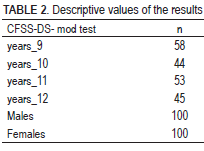Longitudinal changes in the prevalence of dental fear and anxiety in 9–12-year-old children in clinical setting in Bosnia and Herzegovina
DOI:
https://doi.org/10.17532/jhsci.2022.1799Keywords:
Children, dental fear and anxiety, the prevalenceAbstract
Introduction: Dental fear and anxiety (DFA) is a ubiquitous entity among dental patients in terms of their prevalence and incidence. It is among the major clinical problems in dentistry. In addition, the differences in DFA prevalence were present considering the age and gender of patients and over time, but with some opposite reports. The aim of this study is to examine the prevalence of DFA presence in children concerning their age, gender, and over time.
Methods: The survey sample comprised 200 of 9–12-year-old children. The DFA presence was determined twice by the modified version of the CFSS-DS scale (CFSS-DS-mod scale) during a 6-months long period between the first and the subsequent dental appointment due to the need for restorative dental treatment. The scale was applied before the restorative treatment started on both occasions.
Results: The prevalence of DFA was 17.5% in the study sample and decreased over time. It was slightly higher in girls.
Conclusions: The DFA prevalence in 9–12-year-old children is decreasing over time. Latent manifestations of DFA presence should be considered for evaluation in the future.
Downloads

Downloads
Published
License
Copyright (c) 2022 Elmedin Bajrić, Amila Zukanović, Nina Marković, Amra Arslanagić, Selma Zukić, Lajla Hasić-Branković

This work is licensed under a Creative Commons Attribution 4.0 International License.










